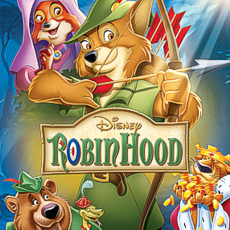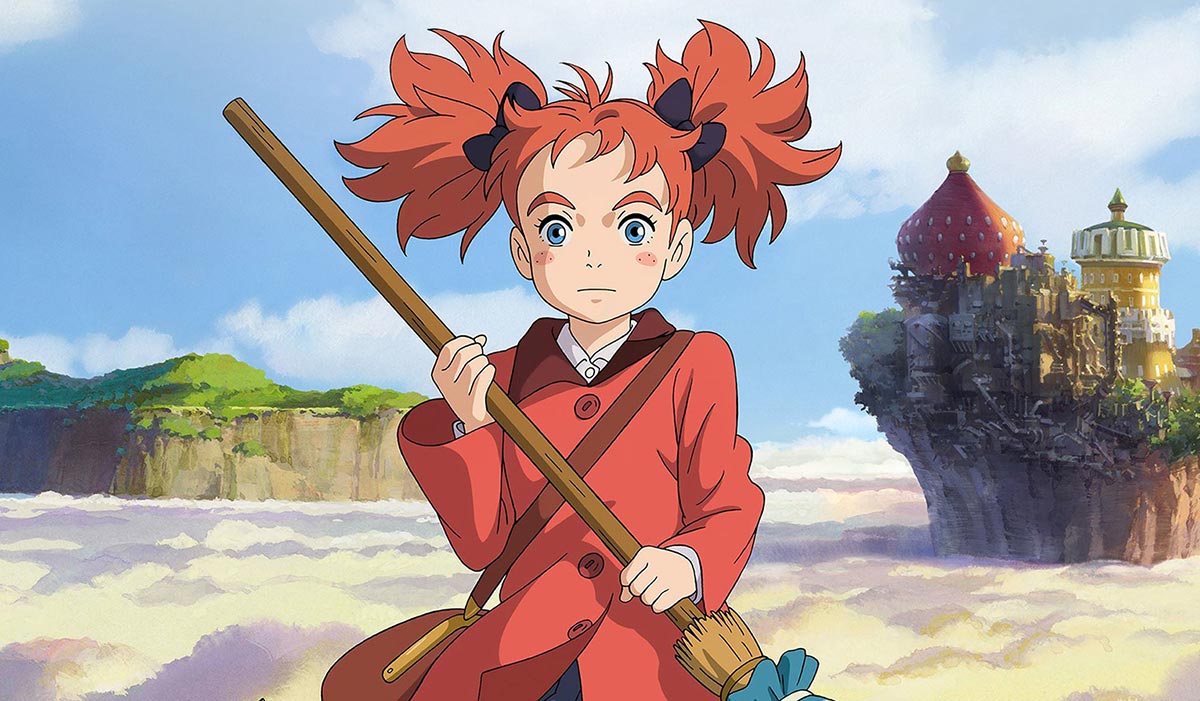Walt Disney Pictures (August 29 1964), Walt Disney Home Entertainment (December 14 2004), 2 discs, 139 mins plus supplements, 1.66:1 anamorphic widescreen, Dolby Digital 5.1 Surround, Rated G, Retail: $29.99
Storyboard:
Wind’s in the East,
Mist’s comin’ in…
Like something is brewin’,
About to begin…

The Sweatbox Review:
There’s certainly something about this Mary!
Though Walt Disney’s personal touch is said to be all over The Jungle Book, The Happiest Millionaire, The Love Bug and, to an extent, The AristoCats – the first few films to emerge from his Studio following his death in 1966 – it is usually Mary Poppins, released just two years before he died, in 1964, that is seen as his swansong, and the only film from later in his career that truly deserves the “masterpiece” tag attributed to early classics such as Snow White, Pinocchio, Fantasia and Bambi.
The reason is simple: Mary Poppins sums up everything that is good about Disney films: great characters, wonderful showmanship and a strong story, even if it is episodic by its book-adapted nature. Like Peter Pan, the story opens with an “all this has happened before” nod and a wink, and tells of a mysterious, magical flying character who enters the lives of turn-of-the-century children and teaches them the realities of life, while the parents – specifically the father – learns that all work is not play and ends up relating to his family better. Unlike Peter Pan, Poppins author P.L. Travers was against an all-cartoon take on her stories, meaning that Walt had to find a different way.
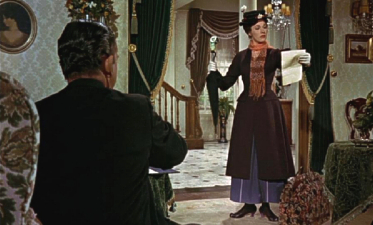
Disney’s many years of filmmaking expertise meant that this basically wasn’t a problem, and Poppins is generally regarded as the film where everything came together. This is Walt playing at the top of his game, and Poppins was a “prestige picture”, meaning that anything and everything director Robert Stevenson and producer Bill Walsh needed was seen to immediately. Live-action (and all the comedy and drama that implies), animation (the cornerstone of the company) and even theme-park innovations such as Audio-Animatronics all went into the melting pot to fully realise Mary’s world and the many adventures and characters she meets along the way.
Now, I could go on extolling the virtues of Walt’s seminal work all week, but you don’t really want to know about Julie Andrews’ fantastic, career breaking – and Oscar winning – performance, or Dick Van Dyke’s hysterically so-bad-it’s-all-part-of-the-fun “Cock-er-nee” English accent, nor even about the protracted history behind the book to screen adaptation. Yes, the film can seem to drag a little in the Uncle Albert section, and the animation may be of the rougher, 1960s Xerox-look that defined 101 Dalmatians and The Sword In The Stone rather than the lushly colored-lines approach of a Peter Pan or even the films of today, but that’s all beside the point.
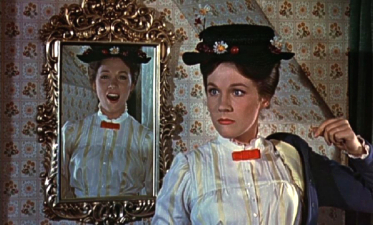
Poppins has a magic all of it’s own, highlighted at the very least by the magnificent matte paintings by the legendary Peter Ellenshaw, and the songs and score by long-time Disney composers Richard and Robert Sherman, and Irwin Kostel, a score that’s been all but ruined by the creators of the soon to open London stage show (and whatever Broadway-bound production that is sure to follow). Do yourselves a favor – forget that terrible, awful mess, not at all like the Poppins we all remember – and pick up the original and, practically perfect in every way, best. All you need to know is that Mary Poppins is not just a Disney classic, but a bona fide movie legend, and as such automatically belongs in your DVD collections!
Is This Thing Loaded?
Frankly put, everything you needed to know about Mary Poppins (but were perhaps unable to have answered) is here. The disc kicks in with the usual Sneak Peeks for other Disney product, among them a mixture of theatrical and DVD coming soon titles including Bambi: Special Platinum Edition, Pooh’s Heffalump Movie, Mulan II and The Princess Diaries 2, with additional previews for other titles from the main menu.
Speaking of which, the menus, as they start up on Disc One, are gorgeous and tons of fun, using footage from the film as well as cleverly manipulated new animation of the penguin waiters to “serve up” the options on the disc! This first disc takes us into the Jolly Holiday sequence, with artwork and animation as the menu backdrops, accompanied with score selections. The first “extra” you’ll find is Disney’s Song Selection, which runs through eight of the film’s complete songs (as opposed to reprises and smaller moments) with or without optional sing-along subtitles in play. A Play All option runs them all through, but why do this when the film works so much better with dialogue and story?!
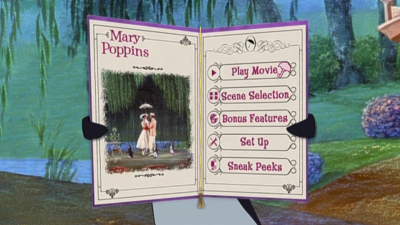
Onto the supplemental features proper, and most fun is the full-length Audio Commentary. Editing together comments from Julie Andrews and Dick Van Dyke (recorded together), Karen Dotrice and Richard Sherman (again recorded together), Richard also kind of serves as “host” for the track, calling up additional words from his brother Robert (now living in England), as well as occasional archive interview snippets from director Robert Stevenson, music maestro Irwin Kostal and Walt Disney himself. An immensely enjoyable track, this is the most fun I’ve had in ages listening to such a commentary, and it never lags, thanks to the large assortment of participants. The mood is as magical as the movie, and it’s clear that everyone enjoyed working on the picture and are proud to be associated with it. Julie Andrews keeps her end of the conversation going the most, but Van Dyke only offers a sporadic tidbit of information here and there while seemingly sitting back and being awed by the film all over again. However, there is a ton of facts and fun to be found, and this is well worth your time!
Adding to the commentary track is a Poppins Pop-Up Fun Facts trivia track, which again is a worthy addition to the set, packing in everything one could wish to know (such as the voices behind the robin whistling with Mary, and her magical umbrella at the film’s end). The track is a subtitle option, so if you’re able to flip between these on your player, I suggest having the audio commentary and this on at the same time, as I did. There’s never too much going on that one can’t keep up with both, and they occasionally compliment each other with extra nuggets of info on a given topic that is under discussion by the filmmakers. An excellent bonus, well tied in to the already exemplary commentary, and a great way to begin immersing yourselves in the experience of Poppins’ creation.
Since the film, especially with those audio mixes and additional tracks, clocks in at almost two hours and twenty minutes, it’s over to Disc Two for the remainder of the bountiful extras, which uses Bert’s sidewalk drawings as the basic for its menu theme. The main menu seems a bit chopped up to me, and I’d have much preferred them to have used the Disc Index as a starting point, with quicker and more straightforward access to the various extras on offer. Going with their version, and following things through in the order they are presented, the first clip is a newly recorded version of a Deleted Song: Chimpanzoo, by the Shermans, and sung here to storyboarded art for the sequence by Richard Sherman. To have taken place during the Uncle Albert section, the song was replaced with I Love To Laugh, though you wouldn’t know that from the way this was presented.
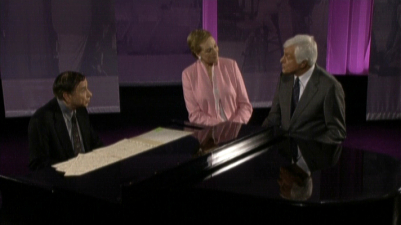
Under the title Music And More, we find a number of generous, newly filmed documentary featurettes. A Magical Musical Reunion lines up Julie Andrews, Dick Van Dyke and Richard Sherman for a just over seventeen minute look back at the tuneful aspects of making the picture. Additional deleted songs are touched on, as well as the inspiration behind some of the film’s biggest hits, and the piece is kept moving by a continually revolving camera and back-and-forth editing. Though some of the exchanges are obviously scripted, and real fans will know many of these stories already, this is a good piece that goes in-depth without outstaying its welcome, and is sure to bring a shiver to the spine and a big, big smile to the face (especially at the end)!
A Musical Journey with Richard Sherman has the charismatic co-composer take on hosting duties on his own, carrying on the theme started in the Reunion featurette. Lasting almost twenty-one minutes, and as with all the supplements here, this is another enjoyable trawl through the archives. Richard is expertly and delightfully inserted into scenes from the movie, even interacting with some of the animated characters as he reveals all about songs and cues that were discarded and some musical secrets (a song sheet confirms that Bedknobs And Broomsticks’ Beautiful Briny Sea was on the list at one point, and the years of my wondering if I’d dreamt I’d seen Poppins in a theater with an intermission are answered too). There are also a few words from his brother Robert (“Hello from London!”), which only goes to make the piece even more poignant. The featurette ends with the Chimpanzoo clip as seen above, but better accessed here, placing the song in context and with a bit of background information. Also, after having spent some minutes in the company of Mr Sherman, it’s a nicer way to play this feature out, rather than just having the clip (literally lifted from this piece) quite coldly presented on it’s own. Very magical in its own right!

The I Love To Laugh Set Top Game is the same that appeared on various international versions of the Mary Poppins DVD, so it won’t be new to all viewers. No less an enjoyable enough addition, the game has a more than passable Ed Wynn impersonator guide the player through the rules and the game, using that “push-button contraption of yours”. Mary Poppins’ umbrella asks the questions, which the player must pick from the varied selection in Uncle Albert’s room in order to help the old boy down. Answer wrongly, and it’s up to the ceiling, and “game over”! Though it may be overly simple, it’s a better than average inclusion – Albert is very well placed into the scene using repeated action from the film – which most players and fans of the film should have fun with.
In Backstage Disney, and as if the two previously covered featurettes weren’t enough, comes the fifty-one minute Supercalifragilisticexpialidocious: The Making Of Mary Poppins, the disc’s true centrepiece and a fantastic documentary, covering all aspects of production already not touched on in the commentary or featurettes. There is a little repeated information, of course, but these all-new interviews, coupled with appropriate archive footage, are brilliant, further examining what made Walt Disney – and Mary Poppins – magical and special. Apart from surviving cast and crew, we hear from British-based Disney expert Brian Sibley (presenter and author on a number of animation and related books well worth seeking out), as well as next generation Disney creators Andreas Deja and Don Hahn as they explain how the film touched them and continues to inspire, and there is archive footage and stills a plenty. As well as a brief nod to Matthew Garber, the boy who played Michael and who died at a tragically young age, the piece finishes off with a tribute not only to Poppins, but to Walt himself, and though it never becomes cloying or mawkish, I don’t mind to admitting that I was in tears by the end, such was the power of this amazing and brilliant man.

Movie Magic is a quick-cut, kid-friendly look at the film’s effects, and feels like one of those promos that run on the Disney Channel, lasting just over seven minutes. It’s a light and breezy peek behind the scenes, which does lead nicely into a couple of Deconstruction Of A Scene clips, namely the Jolly Holiday and Step In Time sequences. Although these are presented again without much context, there isn’t really a need since both are self-explanatory, taking an approach that sees the original on-set footage compared with the final film. During Jolly Holiday’s animated section, a split-screen shows pencil test and rough footage on one side, with the final film on the other, while Step In Time is shown with combined on-set, pre-effects, matte shot and home movie rehearsal footage. Exceptionally interesting stuff, and going much more in-depth than ever before, these two clips last a combined eighteen minutes, a good portion of which is given over to the entire Jolly Holiday scene! A Dick Van Dyke Make-up Test shows off the one-minute piece of film that convinced Walt that Van Dyke could play the over crotchety Mr Dawes Senior, presented here with some narration from Van Dyke (from the commentary) and some musical score accompaniment.

Going on to the film’s release, and we’re presented with a wealth of additional material, including a look at The Gala World Premiere. The Red Carpet collects a series of stills and camera footage to recreate what the atmosphere was like on August 27 1964, when Mary Poppins had its world premiere at Grauman’s Chinese Theater on Hollywood Boulevard. The almost eighteen-minute featurette draws on previously seen footage, radio interviews and newly discovered archive material, as well as a comical outtake from the film’s shooting that will be familiar to those with the Restored LaserDisc and/or Gold DVD editions. The piece finishes with the original Buena Vista fanfare opening, and leads right into the next piece, The Party, which features a post-premiere radio broadcast over images from the premiere party, held on the Chinese Theater’s parking lot. The broadcast is fun to listen to, especially the head of Technicolor’s impromptu remark, while the six-minutes or so of film footage has identification tags applied to point out some of the harder to see faces (including a brief shot of a very young, very Walt-looking Roy E. Disney enjoying a drink with his wife Patty).

A Publicity section features something that’s all too rare on Disney DVDs of late: a selection of original theatrical teasers and trailers. We get Walt’s on-screen introduction to the film, plus original and re-issue previews and TV spots. Also presented is Julie Andrews’ on-screen premiere greeting, which was played at various venues across the country, and to which Andrews was unable to attend due to her filming of another movie, Hawaii. Following this roughly twelve minutes of material, we’re treated to an extensive selection of Still Art Galleries, including a look at the Visual Development, Story Development, Peter Ellenshaw Matte Paintings, the Recording Sessions, Costumes And Make-up, Behind-The-Scenes, Cast Photos, Walt And Friends, more from The Premiere, Publicity and Memorabilia! Though many of the images found here have been used as illustrations in the video supplements, there’s nothing like taking your time to go through and study these pieces, especially the selection of Ellenshaw’s extraordinary mattes and concept paintings.
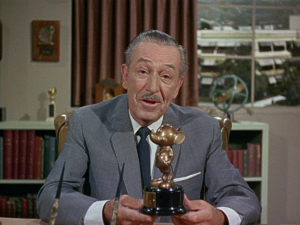
Finally, we come to the all-new, bonus animated short The Cat That Looked At A King. From the packaging, this is a much-touted inclusion in the Mary Poppins package, but on the disc it’s nice and buried at the end of the supplements. That’s a shame, since this witty new piece should have been one of the main menu options at the top of the disc. Based on one of PL Travers’ Poppins stories from the book Mary Poppins Opens The Door, the short tells of a washed-up King (voiced by recent Disney favorite David Ogden Stiers, doing a Pocahontas here and taking on duties as the King’s underling too) who can’t seem to love his bride (Sarah Ferguson…yes, the real once-Royal one) until a magical cat (Tracey Ullman) comes along and convinces him otherwise. A battle of wits transpires, in a comical, 1950’s Disney animation way, that brings the King and Queen together before the cat, Poppins-like, moves on to help another troubled soul.
“Hosted” by Julie Andrews, the live-action bookends take place back at Bert’s sidewalk drawings, recreated using the original London park backdrop, and directed by one time Disney Animation and Studio head Peter Schneider. The animation, directed by Walt Disney Treasures producer Dave Bossert, was co-ordinated by the direct-to-video crowd at the DisneyToon Studios, with animation completed by the Japanese staff of Disney’s now defunct animation company based there. The style invokes the feel of a classic Disney short, though the crisp lines and soft shading are a giveaway of the film’s recent production. Animation in the ten-minute new film is very pleasing, and while not quite up to feature animation standards, it’s streets ahead of what the DTV unit traditionally churns out.
Bringing real magic to the short is Julie Andrews – here basically playing a Poppins-esque version of herself – who recreates some of the poses and lines from the original (“I have no intention of making a spectacle of myself, thank-you very much”). The kids chosen to play her new charges are by turns charming and irritating (the girl is a typical Hollywood brat, though the boy displays a good deal of what made Matthew Garber so memorable), but they quickly clam up as Andrews leaps them into one of the drawings for the story to take place. Presented in 16×9 anamorphic widescreen, and with a title font style that immediately calls up the original and gives a sense of continuity, the one really bad mark against The Cat That Looked At A King is in the scoring of the picture, which has been composed and performed using synthesized samples instead of by a real orchestra. Whereas the production design, animation and performances are all of a level we expect, this cut-price approach to the soundtrack does bring the short down a notch or two and lends it a “cheapness” that Walt would never had allowed.
All in all, the new short encompasses all that is good and bad about this new edition. To use an old cliché (and already worn out in this review alone), this new 40th Anniversary DVD is “practically perfect”, but not quite. Missing from the previous LaserDisc editions and the first Gold DVD is the 17-minute Practically Perfect In Every Way: The Magic Behind The Masterpiece special, an additional (and self-contained) Hollywood Goes To A World Premiere archival featurette and an original theatrical trailer. The Restored LaserDisc also contained an isolated music track that showcased the music score sans vocals and effects. Those with these discs may want to hold on to them for the various frame ratios too (see below), plus the additional audio mixes and extras just listed, but others coming to this set for the first time needn’t feel like they’re missing out – most of the material is basically reproduced or incorporated into the extensive supplements here.
If you’re picking this up online, you could also do a lot worse than to go ahead and order the 40th Anniversary CD soundtrack too. Apart from featuring the complete songs and score over two discs – including sequences never before released in soundtrack form – there are also exclusive audio supplements in the way of deleted song demos, interviews with PL Travers, and a lengthy discussion with the Shermans on the whole project. Very highly recommended!
Case Study:
Consistent with Disney’s bigger animated classics, Mary Poppins comes housed in a foldout slipcover that opens up to list the bonuses to be found inside. While that flip out page doesn’t actually look like the disc holds much, an inserted DVD guide soon reveals the amount of footage and features on offer, plus those all-important Scene Selections. An extra coupon-sized booklet doesn’t give away any decent offers, but advises a visit to the Disney DVD site for a “buy three get one free” deal, plus promo pages for Princess Diaries 2 and Mulan II.
Ink And Paint:
It’s third time around for me and Mary Poppins on videodisc, and I have to say that the results here aren’t as practically perfect as one might like or expect. After years of grainy, pan-and-scan videotape issues and TV showings, the film was originally released to collectors as part of the Exclusive Archive Edition series of LaserDiscs. Mary Poppins was presented in that incarnation from a remastered film print, shown at the apparent “original theatrical aspect ratio” of 1.66:1. Several years later, a Restored Limited Edition LaserDisc – and the same version ported over for Mary’s original Gold Collection DVD – presented the film cleaned up and in Dolby 5.1 and an “original theatrical aspect ratio” of 1.85:1, causing much confusion!
Checking those two discs back today shows that the Exclusive Archive disc, while the rougher print, actually shows the complete 1.66 frame information, while the 1.85 Restored LD/Gold DVD edition hard mattes the images, cropping a little top and bottom (as is consistent with this type of theatrical exhibition). However, THIS new DVD edition goes one further and causes more confusion, presenting essentially an image closer to that 1.85:1 version of the film, but with cropped off areas left and right to create an “original theatrical aspect ratio” 1.66:1 frame, but actually meaning that we lose a sliver from the 1.66 to 1.85 formatting anyway, plus a not so little amount left and right. Very odd, and again annoying, since even though this is basically incorrect framing, the image is amazingly pleasing and, excuse the pun, eye-Poppins, thanks to a pretty extensive clean up from Lowry Images.
Colors are deep, with blacks showing good shadow detail and staying true to the original theatrical exhibition. Apart from a few high contrast scenes, I noticed no edge enhancement on the print, and even the scenes that might be questionable are probably more down to how the film was composited (remember not to confuse EE for the matte lines that do still show here and there, particularly in the animated segment). Likewise, compression artefacts are absent, and this is certainly the best Poppins has ever looked on a home video format, making the slight image cropping that much more irritating. On the flip side, the frame sections lost would likely end up in the blanked out, overscan areas of most viewers’ displays anyway, but it’s not correct and that is that. Practically perfect, but not perfect in any way.
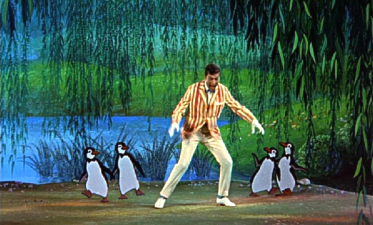
One should also note that this print uses the now-standard Walt Disney Pictures castle logo at the top of the film and not the original Buena Vista fanfare that appeared on film in 1964 and on the Archive and Restored LD and Gold DVD discs.
Scratch Tracks:
Presented with the original Dolby 2.0 Stereo Surround mix as heard in 1964, Mary Poppins also comes bundled with Disney’s Enhanced Home Theater Mix, a new-fangled 5.1 soundtrack designed to give a maximum workout to your home set-ups (it’s also optionally selectable in a 2.0 version as well, for some reason). Historically, and because of the way it was made, the songs in Poppins have always sprung out at an audience when they come crashing in, leaving the dialogue sections of the film (recorded live on the soundstage) to be rendered a little less aggressively and therefore softer in the mix.
The theatrical 2.0 stereo presentation preserves this mix, but the new EHT track finally resolves this issue, and is the one to go for. It also sounds tons better than the faked 5.1 track produced for the Limited Edition LaserDisc/original DVD, thanks to extensive work carried out in starting the mix from scratch. The new track does lose a little of the “ambience” from the original, and adds a little reverb echo to create a feeling of spaciousness, feeling a little “softer” as opposed to the high-end treble of the original. Once one gets used to the new feel, the EHT is generally more pleasing overall. French and Spanish 5.1 dubs are also included. Very good work, almost making up for the image crop.
Final Cut:
One of Walt’s true masterpieces, and possibly his greatest achievement in live-action filmmaking, Mary Poppins really does get better with age. A fantastic children’s and family film, I’ve always gotten nothing but more from it every time I catch up with it over the years. This new edition – apart from the slightly annoying, but ultimately moot aspect ratio points – really does dress up Mary in her best duds and shows her off to her best advantage. The songs and score still delight (and amaze, in the years since I have begun writing myself, the arrangements never fail to impress me), and the animation, in this restored version, looks good as new (any arguments that these scenes are “hokey” can be levelled at the fact that the characters are supposed to be surrounded within a CHALK painting)!
While it doesn’t contain each and every ounce of Poppins-related material created during the film’s production, this edition does a grand job of collating the important bits, topped off with wonderful new supplements that prove that Disney, when they want to, can still pack their discs with content that is better than the rest of them. There’s absolutely no fluff here, and it’s a surprisingly adult/fan packed exploration, with even the Uncle Albert game an enjoyable and well-produced diversion. Coupled with the new CD soundtrack outlined above, this new DVD makes it definitely worth upgrading to – put it on your Santa wish lists now (or hope for one to float down from the sky)!
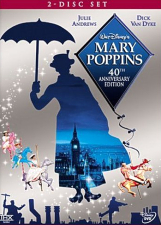 | ||
 |







